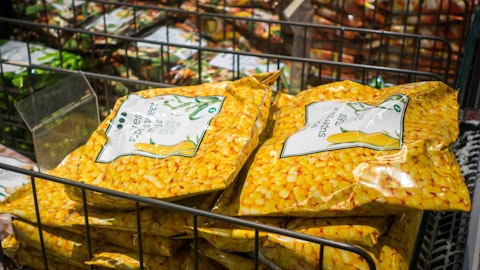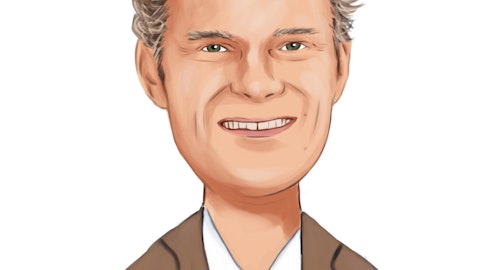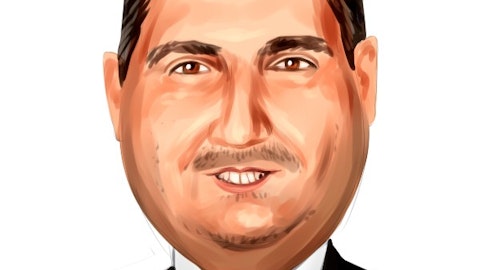There’s a lot more to do and we’ll get a lot of benefit once we get the card spread across the country here. So a lot more work to do in all those areas, John but I would say productivity is the one area we’re ramping up most aggressively.
Operator: Your next question comes from the line of Alex Slagle with Jefferies.
Alexander Slagle: Yes, I was going to ask sort of along the same lines, I mean, the longer-term opportunities around flex scheduling. I mean now, I guess, more than half of [indiscernible]. It just seems like you’ve gotten productivity levels mostly back to pre-COVID levels and sort of normalizing levels of turnover and over time but improvements lately in turnover and safety over time all suggests there could be a good bit more room to go beyond just getting back to [indiscernible] levels of all that? And just — is that accurate and just a little bit more on the sense of kind of where it could go generally before you kind of consider other things like automation and whatnot?
David Flitman: Yes. I think generally, Alex, you’re thinking about it right. I think there’s a lot more runway there and as excited as I am about flex scheduling and my comments in the prepared remarks there, said we’ve seen outsized improvement in our pilot markets. So even where we’ve expanded it — expanded it across the half of our markets, we haven’t yet gotten the productivity uplift that we’ve seen in the pilot and it just takes time, right? It takes the local team time to — to work in the new operating model as well as our associates and we expect continued productivity gains there over time. So we’ll have a lot more to say about long-term productivity targets in June. But just suffice it to say, we’re excited about the work. We think we’re working on the right areas of improvement to drive the focus for the company going forward. And I’m bullish of our ability to continue to lean in and drive productivity.
Operator: Your next question comes from the line of Peter Saleh with BTIG.
Peter Saleh: Congrats on a strong finish to the year. I did want to come back and talk about the compensation for the sales force. You mentioned several changes, variable compensation, more variable focused on private label targets and removing the cap on compensation. Dave, I think you also mentioned this was well received. I’m just curious, have you seen any attrition as this has gone into place? Or are you expecting any attrition from the sales force in 2024 as these changes go into place?
David Flitman: So the gate answer is no. We haven’t seen any nor do I expect any. I think our team did a very good job preparing for this rollout. We had a thoughtful approach to that. Any time you make change even if it’s positive, you’ve got a change management process. You’ve got to leave through and that starts with robust communications. So we did a very nice job of that starting actually very early in the fall last year. So we had plenty of time to not only give our sales team a heads up but kind of model their compensation in the old model and the new model. so they could see what that looks like and importantly, understand what actions, if any, they had to take differently to maintain or actually increase their compensation.
And so as we got further and closer to that date, what we saw was our sellers got excited about it because they see the opportunity to make more money lined up with what we’ve done here. So, I don’t expect any attrition from this with something that we look at very closely all the time, every week, as you would expect. And we haven’t yet seen anything nor do I expect to.
Peter Saleh: Great. And then just on MOXe, I believe you have mentioned 50% of national chains now on MOXe. And I think last quarter, we were somewhere in the 30% range or pretty sizable step-up. Can you just talk about how — how or what you’re seeing in terms of behavior change as more and more of these chains are on this platform? Are you seeing increased case count? Just trying to understand the behavior change post this implementation.
David Flitman: I think it’s actually a little early on the national side to see anything significant change yet. We’re still in the ramp-up phase. We’re pleased that customers are liking it and the bracing it similar to have — the way they have in independent restaurants. And remember, what we said that’s going on in independents is that those customers are buying more and they’re stickier. They stick with us longer. We would expect to see those same sort of benefits through the course of time in the national area, just like we have in independents.
Operator: Your next question comes from the line of Jake Bartlett with Truist Securities.
Jake Bartlett: My first was on product cost inflation. You gave the guidance of 0.5 to 1.5 [ph] were flat in the fourth quarter. Looking back, I think you were actually — it was positive in October if my notes are right. So it looks like it decelerated. And so my question is just about the cadence. What do you expect? Do you expect to start the first quarter out with deflation going to inflation? Just help out on the cadence there? Then I have a follow-up.
Dirk Locascio: Jake, this is Dirk. So I would expect us to see inflation. We saw inflation in the fourth quarter. Actually, in January, we saw some modest inflation again, likely increasing as the year goes on. just I think the overall message embedded within that range is we’re not assuming sort of strong levels of inflation throughout the year. That’s not that different than the last couple of years. We’ve tried to be a little more conservative and drive more of our results through our overall things that we control within our business. But inflation through probably most of the period.
Jake Bartlett: Got it. So the comment of flat with, I guess, for the year as a whole. So another question on just your confidence on continuing to drive gross profit per case in ’24. You mentioned there’s still 40% of your vendors you’re talking with you have some modest inflation. But if you could just talk about what kind of gross profit per case increase you expect what’s embedded in? And maybe how much of that 40% that you think you’re going to be able to hit in ’24 and drive that forward?
Dirk Locascio: Sure. Maybe just back to your deflation question. So the reason we talked about essentially flat. I think it was 15 basis points or so of inflation in the quarter. So very, very important level but it was importantly, a positive. So we’re not going to talk about specifically within the per case increases. I think the important thing though is if you look at really the last 3 years, we’ve continued to drive gross profit and a lot of that’s going to come from a lot of the same initiatives that we talked about maturing as well as some additional things coming on board. But in the cost of goods, we do expect to get through the rest of the tail this year and there are some other activities that we will be doing. In the cost of goods, the thing that we continue to have an advantage versus a lot of others is with our rate of growth and especially our rate of growth with our target customer types.
So, we — as we partner with vendors, we’re bringing them growth in these customer types that they can have more influence in, so we think that it’s a great win-win opportunity. And then as we get some of those savings, we can, again, make sure we’re priced fairly with our customers. We’re going to continue on things like managed cases within logistics. And then at the same time, on OpEx, really striving through our efficiency, whether it’s supply chain Dave talked about, the indirect and other to mitigate most of the cost inflation that we see. So therefore, expecting the GP per case growth to continue to flow through. That message from us of EBITDA growth coming from a combo of profitable growth and margin expansion. You’re going to continue to hear us beat that drum.
We think that’s important and that’s a healthy way to continue to grow over time.
Operator: Your next question comes from the line of Edward Kelly with Wells Fargo.
Edward Kelly: Dave, I wanted to ask you first about M&A. Your [indiscernible] strategy is ramping nicely. You’ll get 2 points of case growth from M&A in ’24. Can you talk about the quality of the business you’re taking on from a margin standpoint? And then how does the pipeline look like moving forward? And is the contribution that you’ll see in ’24? Is that sort of a good placeholder for the run rate as we think about this over time?
David Flitman: Yes. We’re excited about what we’ve done in M&A, Ed and certainly the latest one we talked about here this morning with IWC. And as we said, the majority of their business is in the independent space which is — fits right in our wheelhouse, exactly the type of strategy we want to deploy. And IWC in particular, I didn’t say this on the call but we’re serving that market today but we’re coming through 2 other distribution centers that are probably 3 hours away from the market. So we’re not getting there very efficiently. So in all 3 of the acquisitions, they’ve solved that problem for us and have the right mix of business to help us to continue to drive growth on that platform. So we’re pleased with it. These are accretive and make great sense.
We’re not overpaying for these acquisitions. And to the last part of your question, M&A is hard to predict. We don’t know when deals are coming to the market. We’ve been opportunistic on all 3 of these. We will continue to be but I’d be hard-pressed to predict how the rest of the year may or may not play out. But what you’re seeing us do is drive these tuck-ins in a way that just makes absolute sense for our business over the long haul and that’s what we’ll continue to look for. We think there’s still opportunities out there.
Edward Kelly: Great. And just a follow-up, I guess, for Dirk. Gross profit per case this quarter, Dirk was up a lot less than what it’s been year-over-year. And I think there are some year-end sort of like some of the year-end timing stuff. Maybe could you talk about that? And then as we think about ’24, how do you think about the relationship of GP per case versus OpEx per case in terms of how you grow EBITDA per case. OpEx per case this quarter was actually down a little bit. I’m just kind of curious as to how you think about that relationship in ’24 as well.
Dirk Locascio: Sure. Well, as you pointed out for the fourth quarter, not a real surprise. We’ve talked about this for the last few quarters that you’re going to have different cadence things that play out in gross profit, you’re right, it still stayed at a very strong level that we’ve been at the last couple of quarters. So we’re pleased and I think that demonstrates also again that the benefits are coming and the durability from the things that we’re doing as opposed to whether it’s inflation or deflation. And you’re right. So we talked about that a year ago, there were a few benefits in the fourth quarter and then over the course of this year, we’ve recognized them over the years. So there’s nothing really new or beyond that, as we go into 2024 and less about the specific number but we are very focused on continuing to grow gross profit faster than we do OpEx. And we believe we have a lot of opportunity and let’s come back to my comment on the durability, right?





